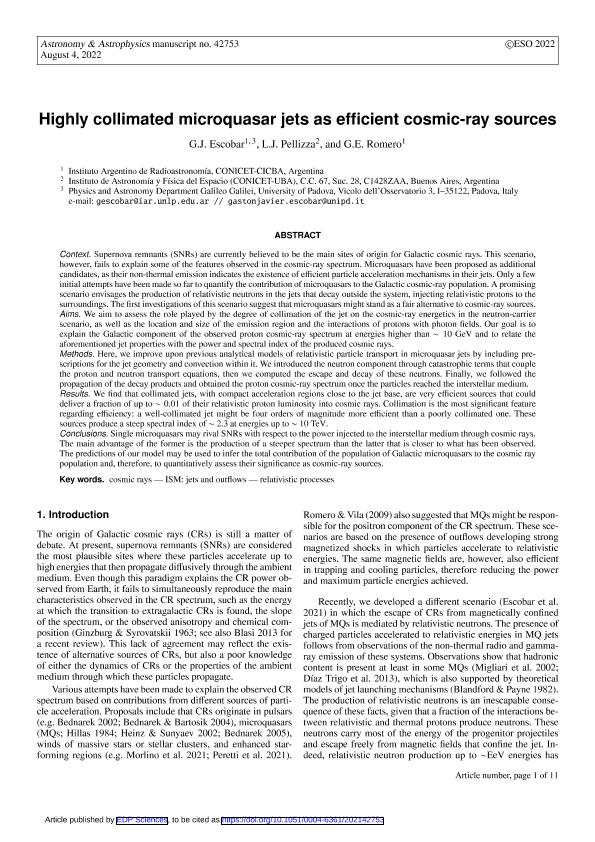Artículo
Highly collimated microquasar jets as efficient cosmic-ray sources
Fecha de publicación:
08/2022
Editorial:
EDP Sciences
Revista:
Astronomy and Astrophysics
ISSN:
0004-6361
Idioma:
Inglés
Tipo de recurso:
Artículo publicado
Clasificación temática:
Resumen
Context. Supernova remnants (SNRs) are currently believed to be the main sites of origin for Galactic cosmic rays. This scenario, however, fails to explain some of the features observed in the cosmic-ray spectrum. Microquasars have been proposed as additional candidates, as their non-thermal emission indicates the existence of efficient particle acceleration mechanisms in their jets. Only a few initial attempts have been made so far to quantify the contribution of microquasars to the Galactic cosmic-ray population. A promising scenario envisages the production of relativistic neutrons in the jets that decay outside the system, injecting relativistic protons to the surroundings. The first investigations of this scenario suggest that microquasars might stand as a fair alternative to cosmic-ray sources. Aims. We aim to assess the role played by the degree of collimation of the jet on the cosmic-ray energetics in the neutron-carrier scenario, as well as the location and size of the emission region and the interactions of protons with photon fields. Our goal is to explain the Galactic component of the observed proton cosmic-ray spectrum at energies higher than 10 GeV and to relate the aforementioned jet properties with the power and spectral index of the produced cosmic rays. Methods. Here, we improve upon previous analytical models of relativistic particle transport in microquasar jets by including prescriptions for the jet geometry and convection within it. We introduced the neutron component through catastrophic terms that couple the proton and neutron transport equations, then we computed the escape and decay of these neutrons. Finally, we followed the propagation of the decay products and obtained the proton cosmic-ray spectrum once the particles reached the interstellar medium. Results. We find that collimated jets, with compact acceleration regions close to the jet base, are very efficient sources that could deliver a fraction of up to 0.01 of their relativistic proton luminosity into cosmic rays. Collimation is the most significant feature regarding efficiency: a well-collimated jet might be four orders of magnitude more efficient than a poorly collimated one. These sources produce a steep spectral index of 2.3 at energies up to 10 TeV. Conclusions. Single microquasars may rival SNRs with respect to the power injected to the interstellar medium through cosmic rays. The main advantage of the former is the production of a steeper spectrum than the latter that is closer to what has been observed. The predictions of our model may be used to infer the total contribution of the population of Galactic microquasars to the cosmic ray population and, therefore, to quantitatively assess their significance as cosmic-ray sources.
Palabras clave:
COSMIC RAYS
,
ISM: JETS AND OUTFLOWS
,
RELATIVISTIC PROCESSES
Archivos asociados
Licencia
Identificadores
Colecciones
Articulos(IAFE)
Articulos de INST.DE ASTRONOMIA Y FISICA DEL ESPACIO(I)
Articulos de INST.DE ASTRONOMIA Y FISICA DEL ESPACIO(I)
Articulos(IAR)
Articulos de INST.ARG.DE RADIOASTRONOMIA (I)
Articulos de INST.ARG.DE RADIOASTRONOMIA (I)
Citación
Escobar, Gastón Javier; Pellizza González, Leonardo Javier; Romero, Gustavo Esteban; Highly collimated microquasar jets as efficient cosmic-ray sources; EDP Sciences; Astronomy and Astrophysics; 665; 8-2022; 1-11
Compartir
Altmétricas




